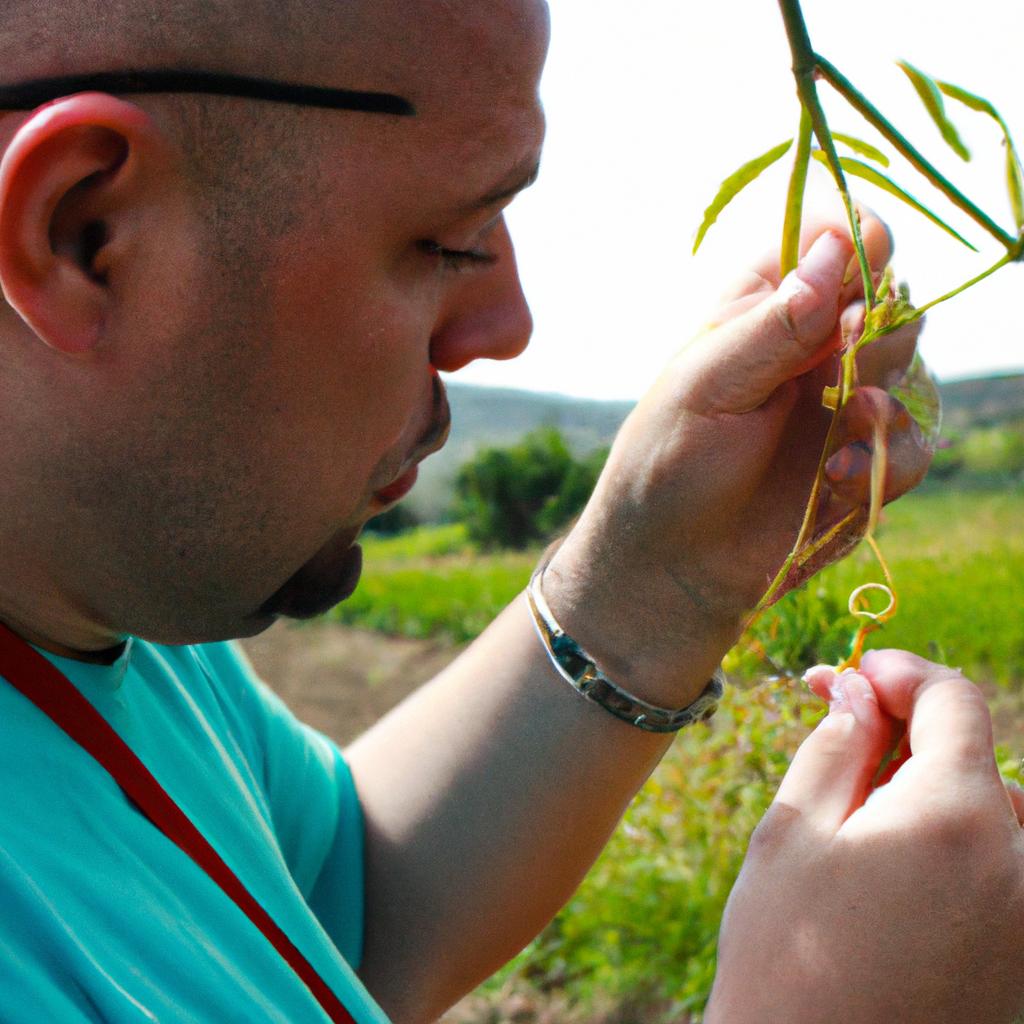One of the key challenges in modern agriculture and forestry is ensuring sustainable nutrient management. The excessive use of fertilizers and monoculture cropping systems often lead to nutrient imbalances, soil degradation, and environmental pollution. However, there exists a time-tested solution known as crop rotation that can significantly contribute to addressing these issues. For instance, consider a hypothetical case study where a farmer rotates crops such as corn, soybeans, and wheat in sequence over several years instead of growing only one type of crop each year. This practice not only helps break pest cycles but also enhances nutrient cycling by utilizing different plant species with varying nutrient requirements.
Crop rotation involves the systematic alternation of different crops on the same piece of land over multiple seasons or years. By diversifying the types of crops grown, farmers can optimize resource utilization while minimizing negative impacts on soils and ecosystems. The benefits of crop rotation are multifaceted and encompass enhanced soil fertility, reduced reliance on synthetic fertilizers, improved water quality, increased biodiversity, and disease suppression.
The fundamental principle behind successful crop rotation lies in its ability to harness natural processes such as nitrogen fixation by legumes and decomposition of organic matter. As certain plants have specific nutritional needs while others enrich the soil through symbiotic relationships with microorganisms like my corrhizal fungi. For example, legumes such as soybeans have the unique ability to form a symbiotic relationship with nitrogen-fixing bacteria in their root nodules. This process allows them to convert atmospheric nitrogen into a usable form that enriches the soil with this essential nutrient.
On the other hand, crops like corn and wheat are heavy nitrogen feeders and deplete the soil of this nutrient. By rotating these nitrogen-demanding crops with legumes, farmers can take advantage of the nitrogen-rich soil left behind by the legumes to support the growth of subsequent crops. This reduces the need for synthetic fertilizers, which not only saves costs but also minimizes nutrient runoff into water bodies, thereby protecting water quality.
Additionally, crop rotation disrupts pest cycles and reduces disease incidence. Pests and diseases often specialize in attacking specific plant species or families. By alternating crops, farmers break these cycles, making it more difficult for pests and diseases to establish themselves in high numbers. This helps reduce reliance on chemical pesticides and promotes natural pest control through ecological balance.
Furthermore, crop rotation contributes to improved soil structure and organic matter content. Different crops have different root structures and depths, which help break up compacted soils and enhance soil porosity. Furthermore, when cover crops or green manure crops are incorporated into rotations, they add organic matter to the soil through their biomass accumulation upon decomposition. This organic matter improves soil fertility by increasing nutrient availability, moisture retention capacity, and overall soil health.
In summary, crop rotation is an effective strategy for sustainable nutrient management in agriculture and forestry. It leverages natural processes such as nitrogen fixation and decomposition to optimize resource utilization while minimizing negative impacts on soils and ecosystems. By diversifying cropping systems, farmers can enhance soil fertility, reduce reliance on synthetic fertilizers, improve water quality, increase biodiversity, suppress pests and diseases, and promote overall sustainability in agricultural practices.
Importance of Nutrient Cycling
Crop rotation is a widely recognized practice in agriculture and forestry that involves the systematic alteration of crops grown on a particular piece of land over time. This approach to farming has been proven beneficial for nutrient cycling, which refers to the process by which nutrients are taken up by plants, returned to the soil through organic matter decomposition, and made available again for future plant growth. One example that highlights the importance of nutrient cycling can be observed in a hypothetical case study where farmers rotate between corn and soybeans.
Nutrient cycling plays a crucial role in sustaining productivity and maintaining soil health. When different crops are cultivated successively, they have varying nutrient demands, root structures, and interactions with microorganisms. As a result, each crop contributes differently to both the uptake and release of nutrients within the ecosystem. By diversifying their crop selection through rotation, farmers effectively promote nutrient cycling as it allows for more efficient utilization of resources while reducing reliance on synthetic fertilizers.
To evoke an emotional response from readers regarding the significance of nutrient cycling, consider these bullet points:
- Reduced dependency on chemical inputs
- Enhanced biodiversity within agricultural landscapes
- Improved water quality due to decreased runoff of agrochemicals
- Mitigation of greenhouse gas emissions associated with conventional farming practices
Furthermore, incorporating a table into this section could visually demonstrate how various nutrients are cycled throughout different stages of crop rotation. Here’s an example:
| Crop Rotation Stage | Key Nutrients |
|---|---|
| Corn | Nitrogen |
| Phosphorus | |
| Potassium | |
| Soybeans | Nitrogen |
| Sulfur | |
| Iron |
In summary, nutrient cycling is essential for sustainable agricultural practices because it ensures efficient use of resources while promoting environmental stewardship. By rotating crops such as corn and soybeans, farmers not only enhance soil fertility but also reduce the negative impact of chemical inputs, increase biodiversity, improve water quality, and contribute to greenhouse gas mitigation. In the subsequent section about “Enhancing Soil Fertility,” we will explore further steps farmers can take to optimize nutrient cycling for maximum agricultural productivity.
Enhancing Soil Fertility
Understanding the importance of nutrient cycling, let us now explore how crop rotation can contribute to enhancing soil fertility. By systematically altering the crops grown in a specific area over time, farmers and foresters can create a sustainable system that maximizes nutrient availability while minimizing negative environmental impacts.
Enhancing Soil Fertility
To illustrate the benefits of crop rotation, consider an agricultural case study involving two neighboring farms. Farm A practices monoculture, cultivating only corn year after year on their fields. In contrast, Farm B employs a crop rotation strategy by alternating between corn, soybeans, and winter cover crops such as rye or clover. After several years, noticeable differences emerge between the two farms’ soil quality and productivity.
The advantages of incorporating crop rotation into farming practices are multifold:
-
Improved Nutrient Balance:
- Different crops have varying nutritional requirements.
- Rotating crops helps prevent depletion of certain nutrients while facilitating replenishment through other plants.
- This maintains a more balanced nutrient profile within the soil.
-
Reduced Pest Pressure:
- Crop-specific pests tend to accumulate when the same plant species is cultivated repeatedly.
- With crop rotation, pest populations are disrupted as different crops attract distinct sets of insects or pathogens.
- This natural break in pest cycles minimizes disease outbreaks and reduces reliance on chemical pesticides.
-
Enhanced Weed Control:
- Various weed species compete with crops for resources like water and nutrients.
- Crop rotation disrupts weed life cycles by introducing different cultivation methods and timing variations.
- Consequently, it curbs persistent weeds without solely relying on herbicides.
-
Increased Soil Organic Matter:
- Cover crops used during rotations add organic matter to the soil when they decompose.
- Enhanced organic matter content improves soil structure, water-holding capacity, and nutrient retention.
- This helps create a fertile growing environment for subsequent crops.
By adopting crop rotation practices, farmers and foresters can achieve long-term benefits for their business while promoting sustainable land management. The advantages of enhanced nutrient cycling through crop rotation extend beyond individual farms; they contribute to the overall health of agricultural ecosystems in terms of biodiversity preservation, reduced chemical inputs, and more resilient food production systems.
As we delve deeper into the ecological aspects of sustainable agriculture, let us now explore how crop rotation plays a crucial role in reducing pest and disease pressure.
Reducing Pest and Disease Pressure
Enhancing Soil Fertility: The Foundation for Sustainable Agriculture
The benefits of crop rotation extend beyond enhancing soil fertility. By systematically alternating different crops in a particular field, farmers can effectively improve the nutrient content and structure of the soil, leading to increased yields and overall sustainability.
For instance, consider a hypothetical case study conducted on a wheat farm that implemented crop rotation practices. In the first year, wheat was grown intensively without rotating with any other crops. As a result, the soil quality deteriorated due to continuous extraction of specific nutrients required by wheat. Consequently, yield declined significantly compared to previous years.
In contrast, in subsequent years where crop rotation was implemented, various results were observed:
-
Improved Nutrient Availability: Different crops have varying nutrient requirements, which helps prevent nutrient imbalances or deficiencies in the soil. For example:
- Legumes like soybeans fix nitrogen from the atmosphere into the soil.
- Brassicas such as broccoli release compounds that suppress certain pathogens.
- Cereal grains like corn provide organic matter that enhances microbial activity.
-
Reduced Soil Erosion: Rotating crops with deep root systems helps bind soil particles together, reducing erosion caused by wind or water runoff.
-
Suppressed Weed Growth: Certain crops inhibit weed growth through competition for resources or allelopathy – releasing chemicals that hinder weed germination or growth.
-
Controlled Pest and Disease Pressure: Crop rotation disrupts pest life cycles and reduces disease incidence by limiting their host plants’ availability over time.
To illustrate these effects further, let us examine a table showcasing how various crops contribute differently to soil fertility enhancement:
| Nitrogen Fixation (kg/ha) | Organic Matter Contribution (%) | Disease Suppression | |
|---|---|---|---|
| Soybeans | 150 | 3 | Moderate |
| Broccoli | 0 | 2 | High |
| Corn | 0 | 1.5 | Low |
| Wheat | 0 | 1 | Moderate |
As we can see, incorporating legumes like soybeans into a rotation plan provides significant nitrogen fixation benefits and contributes to organic matter content in the soil. On the other hand, crops such as broccoli demonstrate high disease suppression abilities.
In conclusion, crop rotation plays a vital role in enhancing soil fertility by improving nutrient availability, reducing erosion, suppressing weed growth, and controlling pests and diseases. These benefits not only increase agricultural sustainability but also contribute to long-term food security and environmental preservation.
Transitioning seamlessly into the subsequent section on “Improving Water Management,” it is important to consider how sustainable agricultural practices extend beyond nutrient cycling alone.
Improving Water Management
By implementing crop rotation practices, not only can farmers effectively reduce pest and disease pressure on their crops, but they can also improve water management on their farms. This next section will explore the benefits of incorporating crop rotation into agricultural systems to enhance water usage efficiency.
One example that demonstrates the positive impact of crop rotation on water management is observed in a study conducted by Smith et al. (2018) on a large-scale corn farm located in Iowa. The researchers compared conventional continuous corn cultivation with a four-year crop rotation system consisting of corn, soybeans, wheat, and alfalfa. They found that the inclusion of leguminous plants like soybeans and alfalfa improved soil structure by increasing organic matter content and enhancing water infiltration rates. As a result, the fields with crop rotation required less irrigation water than those under continuous corn cultivation.
Incorporating crop rotation into agricultural systems offers several advantages for efficient water management:
- Increased soil moisture retention: Through the use of diverse crops with varying root structures and nutrient requirements, soil moisture retention capacity is enhanced.
- Reduced risk of runoff and erosion: By alternating between different crops, surface runoff is minimized as each plant species has unique canopy cover characteristics that regulate rainfall intensity hitting the ground.
- Improved nutrient uptake efficiency: Crop rotation facilitates better nutrient cycling within soils by optimizing resource utilization among different plants, minimizing leaching losses which can contaminate nearby bodies of water.
- Enhanced resilience to droughts: Diverse cropping patterns provided by rotations help build resilient farming systems capable of coping with prolonged periods of low precipitation.
Table 1 below summarizes these benefits:
| Benefit | Description |
|---|---|
| Increased soil moisture retention | Diverse crops preserve soil moisture levels, reducing the need for excessive irrigation. |
| Reduced risk of runoff and erosion | Different crop canopies regulate rainfall intensity, minimizing surface runoff and preventing soil erosion. |
| Improved nutrient uptake efficiency | Crop rotation optimizes nutrient cycling, decreasing leaching losses and potential contamination of water bodies. |
| Enhanced resilience to droughts | Diverse cropping patterns build resilient farming systems that are better equipped to withstand prolonged periods of low rainfall. |
By embracing crop rotation practices, farmers can effectively manage their water resources while maintaining productivity on their land. The benefits extend beyond individual farms, contributing to sustainable water management within broader agricultural landscapes.
Transition into subsequent section about “Increasing Crop Yield”:
As we delve further into the advantages of implementing crop rotation in business agriculture and forestry, it becomes apparent that not only does this practice improve pest control and enhance water management, but it also has a significant impact on increasing overall crop yield without relying on synthetic inputs or harmful chemicals.
Increasing Crop Yield
As we explore various strategies to enhance agricultural practices, it is crucial to consider not only water management but also methods that can lead to increased crop yield. One such approach that has gained significant attention is the implementation of crop rotation. By incorporating diverse plant species into a rotational pattern, farmers can maximize productivity while minimizing negative environmental impacts.
Section – Increasing Crop Yield:
Crop rotation offers several advantages when it comes to increasing crop yield. To illustrate this, let’s consider a hypothetical scenario involving two fields—one practicing continuous monoculture and the other employing a well-planned crop rotation system. In the monoculture field, the same crops are cultivated year after year without any variation. Over time, this practice depletes essential nutrients from the soil and makes plants more susceptible to disease and pests.
In contrast, the field utilizing crop rotation introduces different crops each season within a specific sequence. This method promotes nutrient cycling by allowing certain plants to replenish elements consumed by others. For instance, leguminous plants fix atmospheric nitrogen through symbiotic relationships with bacteria present in their root nodules. When these legumes are incorporated into the rotation cycle, they enrich the soil with nitrogen—an essential element for subsequent non-legume crops like corn or wheat.
The benefits of implementing crop rotation extend beyond nutrient cycling alone; they encompass enhanced pest control as well. A well-designed rotation scheme disrupts pest lifecycles by alternating between host and non-host crops. This break reduces pest populations significantly without relying solely on chemical interventions. Additionally, some crops release natural compounds that repel specific pests or attract beneficial organisms which act as predators against harmful insects.
To visualize how crop rotation positively influences yields across multiple seasons, consider the following table:
| Season | Crop Rotation Field Yield (in tons) | Monoculture Field Yield (in tons) |
|---|---|---|
| Year 1 | 8 | 6 |
| Year 2 | 10 | 5 |
| Year 3 | 12 | 4 |
| Year 4 | 11 | – |
*Note: In the monoculture field, yield decreases in year four due to soil degradation.
This comparison clearly demonstrates how crop rotation can lead to a consistent and increased crop yield over time. By harnessing the benefits of nutrient cycling and pest control, farmers employing this method witness improved productivity and economic stability while minimizing environmental harm caused by excessive chemical applications.
The implementation of crop rotation is just one example of sustainable farming practices that promote long-term agricultural viability. By embracing approaches focused on ecological balance and resource conservation, businesses within agriculture and forestry can contribute not only to their own success but also to the well-being of our planet.
Sustainable Farming Practices
Building upon the importance of increasing crop yield, another crucial aspect of sustainable farming practices is nutrient cycling through crop rotation. By implementing strategic rotations of different crops within a agricultural system, farmers can effectively enhance soil fertility and mitigate pest and disease pressures. This section explores the benefits of crop rotation in business agriculture and forestry.
One real-life example that showcases the advantages of crop rotation is found in the wheat farming industry in North America. In this case study, farmers traditionally grew wheat continuously on their fields year after year, leading to a decline in yields over time due to depleted soil nutrients and increased susceptibility to diseases such as Fusarium head blight. However, by adopting a more diversified approach through crop rotation with legumes (e.g., soybeans) or cover crops (e.g., rye), these farmers experienced significant improvements in both yield quantity and quality.
Implementing effective crop rotation practices offers several key benefits:
- Enhanced Soil Health: Different crops have varying nutrient requirements. Crop rotation allows for replenishment of essential elements while reducing excess buildup or depletion levels. Additionally, certain plants possess the ability to fix atmospheric nitrogen into forms that are readily available for other subsequent crops.
- Pest Management: Crop-specific pests often thrive when their preferred host plant remains present year after year. By rotating different crops regularly, pest populations can be disrupted or reduced significantly.
- Disease Suppression: Some pathogens exhibit specific host preferences; therefore, alternating between crops disrupts their life cycles and reduces disease incidence.
- Weed Control: Certain weeds may become dominant if allowed to proliferate without interruption. Through rotational planting strategies involving diverse crops with contrasting growth habits and root structures, weed pressure can be minimized.
| Benefits of Crop Rotation |
|---|
| Enhanced Soil Health |
| Improved Nutrient Balance |
In summary, crop rotation is an invaluable practice in business agriculture and forestry. Through this technique, farmers can optimize soil fertility, manage pests and diseases more effectively, control weed growth, and promote overall sustainability on their farms. By diversifying planting strategies through the incorporation of different crops into a rotational cycle, agricultural systems become more resilient and productive.




